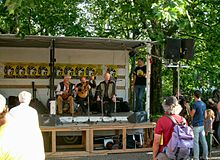Schwabing riots
The riots that took place in Munich 's Schwabing district in June 1962 are known as Schwabing riots .
course
Because a group of young street musicians was still playing after 10:30 p.m. on June 21, 1962, a city councilor and residents of Leopoldstrasse called the police after an unsuccessful attempt to calm things down themselves. When the police (under police chief Anton Heigl ) tried to disband the group and arrest the five musicians temporarily, there were scuffles with young people, and the situation escalated. During the night and on the following four days, street battles between up to 40,000 mainly young protesters and, in some cases, mounted police officers broke out in the entire area around Ludwig Maximilians University (LMU). People from other cities came to the last evenings.
consequences
There was high property damage. A total of around 400 people were arrested, and some were later sentenced to small fines or imprisonment. The numerous reports against police officers were mostly without consequences.
There was a certain interaction between the militancy on the part of some protesters and the massive use of baton by the police, so that public criticism of the police's methods became louder and louder. After the riots, the Munich police, under the leadership of Manfred Schreiber, developed a concept that, for the first time in Germany, relied on approaches to de-escalation in order to avoid future events of this kind (“ Munich Line ”). In the course of the police reforms, a police psychologist has now been deployed in Munich , but at the same time the means of criminal prosecution have been expanded through the use of film teams.
One of the participants in the riots was the then rather apolitical later RAF terrorist Andreas Baader . The importance of the "Schwabing riots" for Baader's political development was widely discussed. Baader's mother herself reports that, under the impression of the "riots", Andreas Baader said: "You know mother, in a state where the police use rubber truncheons against singing young people, something is wrong." The publicist Butz Peters is certain that the events of the Munich city summer in 1962 were “a shocking experience for the nineteen year old”.
rating
According to the historian Detlef Siegfried (University of Copenhagen), the "Schwabing riots" are "one of the most outstanding immaterial places of remembrance in the Federal Republic - a mythical event that seems to indicate the end of the Adenauer era and the liberalization of the Federal Republic."
The ideological place of Schwabing riots between the so-called Halbstark riots of the late 1950s and the student riots of '68 was long unclear and is still a matter of discussion. High school students, apprentices and young workers participated in the protests. No concrete political demands were made at first; The focus was on the right to cultural self-determination . The historian Stefan Hemler speaks of a “generational-youth-cultural conflict signal” that can only be described in a more abstract sense as “one of the harbingers of '1968'”.
Individual evidence
- ↑ 850 years of Munich - cosmopolitan city - heart? ( Memento from June 17, 2008 in the Internet Archive ) on br.online.de
- ↑ Michael Sturm: Authorities gone wild? In: Gerhard Fürmetz (Ed.): Schwabinger riots. Essen 2006, pp. 59–105, here p. 100
- ↑ Michael Sturm: Authorities gone wild? In: Gerhard Fürmetz (Ed.): Schwabinger riots. Essen 2006, pp. 59–105, here pp. 84–86
- ↑ Quoted from Butz Peters: RAF: Terrorism in Germany. Stuttgart 1991, p. 39
- ↑ reviews to Gerhard Fürmetz (ed.): Schwabing riots. on sehepunkte.de
- ↑ Stefan Hemler: Rebellion of a youth scene. In: Gerhard Fürmetz (Ed.): Schwabinger riots. Essen 2006, pp. 25–57, here p. 57
literature
- Gerhard Fürmetz (ed.): Schwabing riots. Protest, police and the public in the early 1960s. Essen 2006, ISBN 3-89861-513-8 ( review )
- Hans-Jochen Vogel : The chain of office. My 12 years in Munich. An experience report. Munich 1972.
- Cantz, Kerstin: Fräulein Zeisig and early death, 978-3-426-52261-5 , Knauer 2019, crime thriller that picks up on the Schwabing riots
Web links
- Interview with Wolfram Kunkel, one of the street musicians
- Representation in the sub-bavaria Wiki
- Conference report of the Berlin Science Center for Social Research
- Judgment of the Federal Administrative Court
- Club-Voltaire Munich ( Memento from September 28, 2007 in the Internet Archive )
- Lebensgeschichten.net
- Peter Maxwill: rubber truncheons free! In: one day from June 22, 2012
- The beginning of the rebellion: The Schwabing Riots 1962 , radio feature by Georg Gruber, Deutschlandradio Kultur 2012
Coordinates: 48 ° 9 ′ 2.5 ″ N , 11 ° 34 ′ 50.9 ″ E
